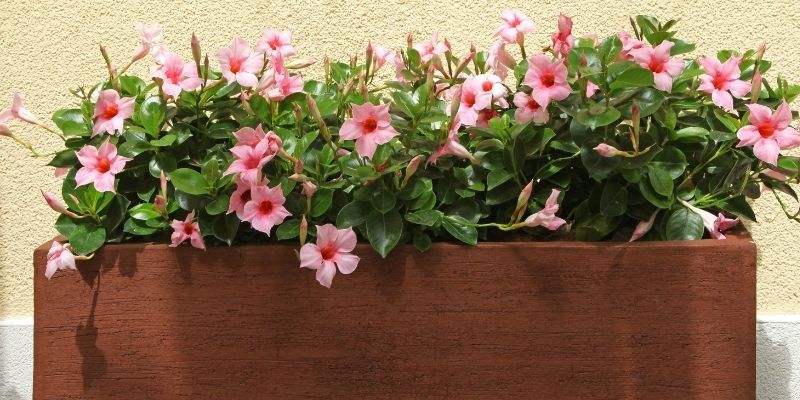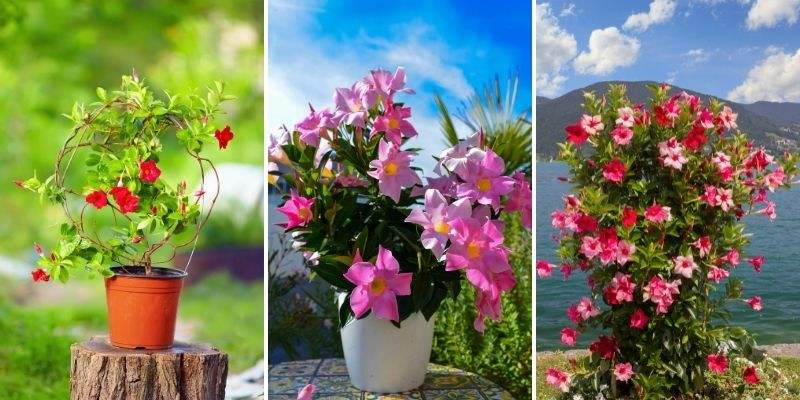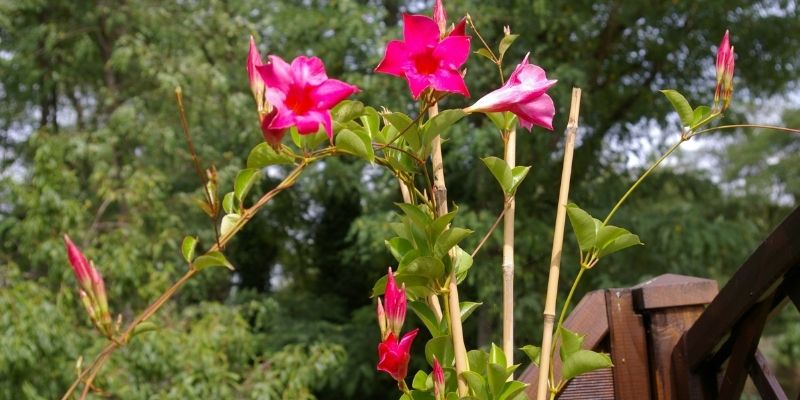A plant with evergreen foliage and stunning star-shaped trumpet flowers, the dipladenia (or Brazilian Jasmine) brings colour and exotic flair from early summer until the first frosts. Not very hardy, in colder regions, the mandevilla is grown as an annual in the garden or in pots that can then be brought indoors in winter. In milder climates, it can be planted directly in the ground, in flower beds, borders or rockeries. Capable of withstanding summer heat, not very thirsty and with fairly rapid growth, note that dipladenias require regular pruning to maintain a beautiful appearance and vigour, as well as to ensure abundant flowering. Since dipladenia flowers appear on the year's new shoots, maintenance pruning should not be done at just any time, as this could compromise flowering. Discover our tips for successfully pruning your dipladenia, whether in climbing or bush form!

This dipladenia in a planter has a beautiful shape and homogeneous flowering thanks to pruning.
Why prune dipladenia?
Pruning dipladenia is not obligatory, but highly recommended for several reasons. Annual pruning is important from an aesthetic point of view, but it also has a revitalising effect. It helps maintain a compact, bushy habit by stimulating the production of new shoots. Flowering will then be more abundant. Finally, by removing dead or diseased parts, the plant has a better chance of staying healthy and living longer.

On the left, a frail, sparsely branched dipladenia. In the centre, a potted dipladenia with a compact, bushy habit. On the right, a dipladenia climbing its support and bearing numerous flowers.
When should you prune dipladenia?
The best time to prune dipladenia is in late winter (February/March), before growth resumes. Older specimens (minimum 3 years) are rejuvenated at this time. Regular pinching of the tips of young shoots is necessary to encourage flowering. This is also the ideal time to repot your dipladenia (every 1 to 2 years).
In late autumn, after flowering, if your dipladenia is too large, you can prune it to reduce its size before overwintering it indoors. Moreover, if your storage location is dark, cutting back is necessary to encourage branching and flowering the following year. This climbing plant loves light, and overwintering in darkness will delay flowering. Winter pruning will help it recover in spring.
Throughout the flowering period, remove spent flowers to encourage new blooms. During its growth period, let your dipladenia develop freely; do not prune it. Stake long stems as they grow. Only shorten stems that have become obstructive and can no longer be guided onto your support.
Tools for pruning dipladenia
Use clean, disinfected and perfectly sharpened secateurs to avoid transmitting any diseases to your dipladenia. Ensure cuts are clean when pruning your plant. Due to its toxic, sticky and irritating white sap that oozes from the stems when pruned, wear a pair of gloves.
How to prune dipladenias?
Maintenance pruning of dipladenias
- Start by removing dry, dead or diseased stems and leaves.
- Using secateurs, cut back the longest secondary voluble stems (thin, green ones) to 3 or 4 buds from the main stems (thick, brown and grey ones). Always prune above a bud or shoot.
- Cut completely dead main branches back to the base. Note that dipladenia has a good ability to produce vigorous new shoots from the stump. If the size of your dipladenia doesn't suit you and it's growing too tall, you can carry out more severe pruning by cutting the main stems (also called framework branches) back by half.
- Remove any remaining spent flowers and pod-shaped fruits.
- Once your maintenance pruning is complete, adjust the substrate level and train the stems onto the support.

Here, you can see an old brown stem on the left and a young green stem on the right.
Pinching dipladenias
Pinching involves cutting the terminal bud at the end of a stem. You should pinch every 4 to 5 weeks. Take the tip of a young stem between your thumb and forefinger. Pinch it with your nails to cut it (remove about 3-4 centimetres of stem). The plant will then branch out, producing new shoots, and you'll get more flowers. For young, still small plants, regular pinching is sufficient; maintenance pruning is not necessary.
How to train a dipladenia to climb?
Semi-climbing or climbing dipladenias can be used in two ways: as a trailing plant (for example in a hanging basket or on a wall where they cascade down) or as a climbing plant. In the latter case, the dipladenia needs to be trained onto a support when planted. By installing the support at this time, the roots are not damaged. Indeed, if you insert your support after the plant has become well-rooted after a long period in the ground, you risk damaging the root system. There is a wide choice of supports in different shapes and materials (wood, bamboo, metal): trellises, pergolas, wire mesh, arches, columns, teepees. First position the support and ensure it is firmly anchored, then plant your dipladenia. Guide the voluble stems onto the support, distributing them evenly (naturally, its stems coil anti-clockwise). Handle them gently. You can tie them with natural-material ties (raffia, string), without tying too tightly. Continue to direct your plant's stems as it grows.
To go further
- Discover our range of dipladenias on our website, as well as a selection of climbing plants
- To keep your dipladenia, read our guide Dipladenia in Winter: Protecting it from the Cold
- Follow our 10 Tips for Successful Dipladenia Cultivation



































Comments